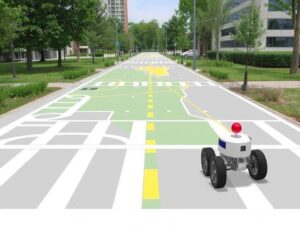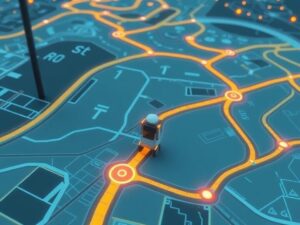Imagine a robot moving in a busy warehouse or an autonomous car driving on roads independently. All because of autonomous navigation path planning algorithms, the mind that tells them how they are going to move. The algorithms enable the machines to move around in the world, recognise where they wish to go, and find the safest and optimal route to arrive there. The article dissects the phenomenon of such programs, their nature, issues, and the future.
What are autonomous navigation path planning algorithms?
Autonomous navigation path planning algorithms are those algorithms that offer autonomous robots and agents the computation of the optimal path between a destination position and an initial position. It is bridging instruction maps to commands. They receive different parameters such as robot ability, terrain, and obstacles and compute the best and collision-free path. They are present in most applications, from autonomous package delivery and warehouse robots to self-driving cars and space travel.
Why Are Path Planning Algorithms Even Needed?
- Efficiency: They have the robots move as fast as they do at a reasonable price but without wasting time and energy.
- Safety: They avoid robot-robot and robot-object/human crashes.
- Autonomy: They design robots that are capable of moving independently with little or no physical human intervention.
- Accessibility: They are able to position robots in a state that is dangerous or non-survivable for human individuals.
Types of Autonomous Navigation Path Planning Algorithms
Autonomous navigation path planning algorithms belong in some general categories based on their merits and demerits:
1. Classical Path Planning Algorithms
They make use of the entire map of the environment and utilise a mathematical technique for the shortest path search.
- A Search: A is the most frequently used algorithm, which uses the application of a heuristic function to return the estimation of the cost of any path from any node to the goal node. A* does optimum search and space searching of the shortest path. A* is a maze-solving wizard.
- Dijkstra’s algorithm: Dijkstra computes the shortest path between graph vertices. A* definitely will find optimal but is too computationally intensive on machines for worlds that.


2. Breadth-First Search (BFS)
BFS expands level by level outward from the starting world. Not as useful if worlds are extremely complicated but very easy to implement.
3. Sampling-Based Path Planning Algorithms
It does not sample the entire world map. It samples points within the space of world configuration points and connects them in sequence to create a path.
- Probabilistic Roadmaps (PRM): PRM constructs a roadmap by taking random samples of the world at locations and connecting them if they don’t occlude each other. It is well-suited to worlds whose obstructions are extremely dense.
- Rapidly-exploring Random Trees (RRT): RRT extends a motion tree from the initial position with new random motion. RRT is especially useful in high-dimensional space configuration.
4. Reactive Path Planning Algorithms
Reactive path planning algorithms react to changes in the environment in real time. They are used most commonly in dynamic environments with moving obstacles as well.
- Bug Algorithms: Bug algorithms travel along the perimeter of the obstacle until the target is reached. They are simple to implement but suffer from local minima.
- Potential Fields: Potential field algorithms establish a virtual force field for the robot as attractive forces to nudge the robot towards the goal and repulsive forces to nudge the robot away from the obstacles.
5. Hybrid Path Planning Algorithms
These algorithms combine heterogeneous approaches to take advantage of their power. A case in point is the hybrid algorithm with a global planner for computing the initial path and the local planner to update the path and respond to moving obstacles.
Challenges in Autonomous Navigation Path Planning
Autonomous navigation path planning algorithms do present some design challenges:
- Dynamic Environments: Dynamic environments and obstacle responses require intelligent algorithms that can learn in real time.
- Computational Complexity: It is computationally expensive to calculate the optimal path in the very complex world, especially in the high-dimensional configuration space.
- Sensor Uncertainty: Robots construct their perception using sensors, and sensors are noisy and imperfect and hence make the path invalid.
- Localisation: Robots need to have a sense of location so that they can plan a path. Localisation failure results in navigation failure.
- Scalability: Scalability to complex and large environments is maybe the largest challenge for algorithms to be developed.
Applications of Autonomous Navigation Path Planning Algorithms
Autonomous navigation path planning algorithms are employed in different applications across domains:
- Robotics: Path planning is a fundamental aspect of robots’ functionality, ranging from manufacturing robots to cleaning robots.
- Self-Driving Cars: Path planning is a fundamental aspect of self-driving cars to drive safely and efficiently on roads.
- Unmanned Aerial Vehicles (UAVs): Path planning allows drones to fly over and conduct activities such as aerial photography and surveillance.
- Logistics and Warehousing: Robots used in warehouses utilise path planning for product pickup and product drop-off in order to permit efficient transfer of goods between.
- Space Exploration: Mars rovers and planetary rovers use path planning in an effort to.


The Future of Autonomous Navigation Path Planning
The field of path planning algorithms for autonomous navigation is expanding broader and broader. Researchers create more efficient, more robust, and even more general algorithms that could possibly provide a solution to the problem of challenging dynamic environments. Some of the promising directions of research are:
- Learning-based Path Planning: Application of machine learning for optimisation through experience-based learning in path planning.
- Multi-agent Path Planning: Planning of the paths for the coordinated movement of multiple robots or vehicles to a common destination.
- Human-aware Path Planning: Planning techniques that possess the ability to honour human preference and action.
- Explainable Path Planning: Planning methods that can explain why it did something particular and thus are predictable and trustworthy.
Path planning methodologies of autonomous transportation provide the basis for enabling robots and other autonomous systems to make their way through the world intelligently.
With rudimentary search techniques to powerful learning-based ones, the methodologies are increasingly adept at addressing the task of progressively dynamic environments. With more technology development, we can only wish for even brighter and smarter path-planning algorithms in the future, and that will guide us into our future world where humans and robots live in harmony. The future of autonomous navigation is bright, and autonomous navigation path planning algorithms will be the ones to take us there.








































Leave a Review